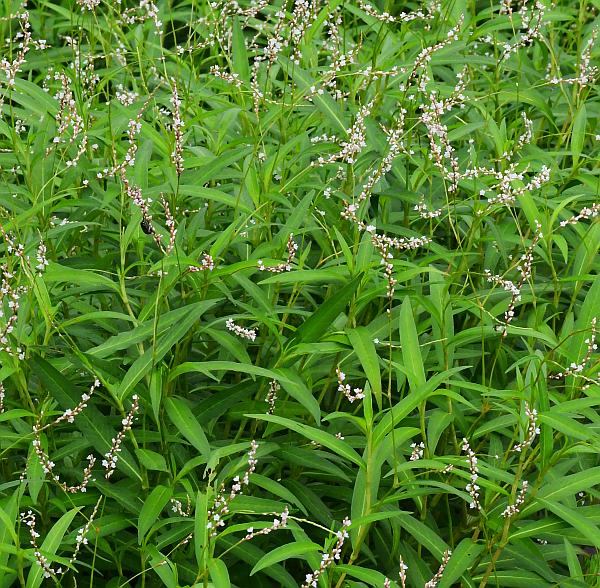Persicaria hydropiperoides (Michx.) Small
Wild Water Pepper

Native
CC = 4
CW = -5
MOC = 66
© SRTurner
Persicaria hydropiperoides (Michx.) SmallWild Water Pepper | |
 |
Native CC = 4 CW = -5 MOC = 66 |
© SRTurner |
|
Family - Polygonaceae Habit - Perennial forb, with fibrous roots and often rhizomes, the stems often also rooting at the lower nodes. Stems - Weakly ascending, to 1.0 m, sometimes ascending from a spreading base, branching, glabrous or sparsely appressed-hairy toward the tip, not glandular. Ocreae persistent, usually tearing with age, 5-12 mm long, somewhat inflated toward the base, light brown to brown and papery throughout, truncate, not oblique at the tip, lacking a flange of tissue at the tip, the margin with bristles 4-10 mm long, the surface glabrous or appressed-hairy, not gland-dotted.
Leaves - Alternate, simple. Petioles essentially absent or to 2 cm long, appressed-hairy. Leaf blades 5-22 cm long, 0.5-3.7 cm wide, linear or more commonly narrowly to broadly lanceolate, angled or tapered at the base, tapered to a sharply pointed tip, the surfaces glabrous or appressed-hairy, sometimes only along the main veins, unarmed, the undersurface sometimes with impressed glands, the upper surface lacking a reddish or purplish marking.
Inflorescence - Spikes or spikelike racemes, terminal and axillary from the upper leaves, usually few to numerous per main stem, 3-8 cm long, 2-5 mm wide, erect or ascending, straight or somewhat curved or arched, relatively dense, uninterrupted or sometimes interrupted toward the base, the stalk 1-3 cm long, glabrous or minutely roughened to appressed-hairy, not glandular. Ocreolae mostly overlapping (except sometimes toward the inflorescence base), the margins with bristles mostly 1-2 mm long (mostly shorter than the ocreolae), the surface glabrous or more commonly appressed-hairy, not gland-dotted.
Flowers - Perfect or staminate, 2-6 per fascicle. Perianth pinkish green to pink toward the base, white to more commonly green or pinkish-tinged toward the tip, bell-shaped, not gland-dotted or sometimes gland-dotted only on the inner 2 tepals, the tepals 5, 1.5-3.0 mm long, in perfect flowers becoming enlarged to 2.5-4.0 mm at fruiting, fused below the midpoint, the nerves inconspicuous, irregularly few-branched, open-branched. Stamens 8, exserted only in staminate flowers, the anthers pink to red. Styles 3-branched from near the base, not exserted, not persistent.
Fruits - Achenes 1.5-3.0 mm long, 1.0-2.3 mm wide, not or only slightly exserted, 3-angled, beakless, the faces flat or slightly concave, lacking a central hump, the surface smooth, dark brown to black, shiny. Flowering - June - November. Habitat - Streambanks, pond margins, bases of bluffs, swamps, marshes, fens, bottomland forest openings, moist swales in prairies, ditches, railroads; sometimes emergent aquatics. Origin - Native to the U.S. Lookalikes - P. hydropiper, P. setacea. Other info. - This is a common species in much of Missouri, though it is apparently missing from large areas toward the northwestern part of the state. It also occurs throughout most of the continental U.S. with the exception of a few central-western states. Many of the smartweeds look similar. This one has narrow inflorescences which usually appear mostly white, and flowers which lack punctations (small impressed stippling) on the tepals. The ocreae on the stem nodes are papery and have bristles on their top margins. The plant always grows near or in water. The species name means "looks like water pepper" referring to the plants resemblance to the related P. hydropiper. That species is differentiated by having stippled tepals, fruits which are dull instead of shiny, and inflorescences which normally nod at the tips. Another closely related lookalike, P. setacea, has ocreae and leaf petioles which are spreading-hairy. Photographs taken at the Shawnee Trail Conservation Area, Barton County, MO., 7-28-00 (DETenaglia); also at Big Cane Conservation Area, Butler County, MO, 8-27-2015 and 9-7-2019, and Shaw Nature Reserve, Franklin County, MO, 7-22-2020 and 8-21-2021 (SRTurner). |